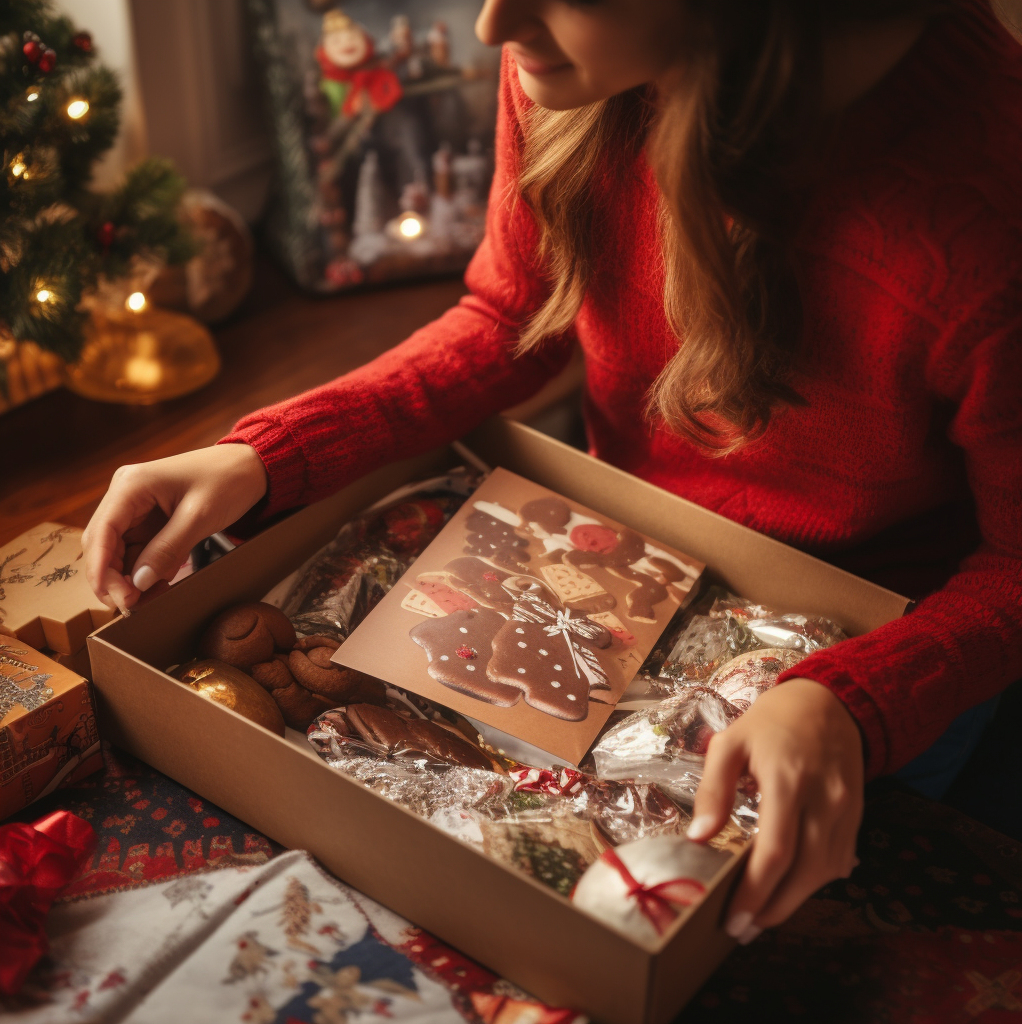Meet Emily, a college sophomore who can’t make it home for Christmas. While she’s thriving academically and socially, this holiday season leaves her feeling homesick. But a care package from her family becomes more than just a box of goodies—it’s a lifeline to her traditions and stories, helping her cross the borders of time and space.
Emily’s phone buzzes with a notification. It’s a message from the front desk—she has a package waiting for her. As she slices through the tape with a pair of borrowed scissors, a whiff of cinnamon fills the air, transporting her straight back to her family’s kitchen. Her hands tremble with excitement as she unwraps a carefully baked batch of her grandma’s famous Christmas cookies, a collection of her favorite Christmas tree ornaments, and a handwritten letter from her mom.
The tactile experience is overwhelming. The crinkle of tissue paper, the aroma of baked goods, and the glint of ornaments against the dorm room lighting—it’s a sensory capsule of home. Each item in the box is imbued with meaning, from the cookies that follow a recipe passed down through generations to the ornaments that have adorned her family’s Christmas tree since she was a child.
As Emily hangs the heirloom ornaments on her mini dorm-room Christmas tree, her mind wanders back to the holiday get-togethers of her past. She hears the laughter of her cousins echoing in her ears, remembers the warmth of her grandpa’s bear hugs, and can almost taste her aunt’s legendary pumpkin pie.
These gatherings were more than just holiday parties; they were storytelling sessions. Whether it was her dad recounting his college escapades or her grandma sharing tales of their ancestors, stories flowed as freely as eggnog. As a kid, Emily loved hearing these narratives, never realizing how crucial they were in shaping her identity and resilience. These stories were her first history lessons, her initial glimpses into the complexities of love and life, and above all, they were her guide to who she was in the grand scheme of her large, sprawling family.
Turns out, Emily’s fondness for family stories is more than just sentimental; it’s actually supported by research. A study conducted by psychologists has shown that children who know stories about their family tend to be more resilient, especially when facing challenges like spending holidays away from loved ones. Knowing the struggles and triumphs of their ancestors provides them with a broader sense of self and helps them navigate their own challenges with greater ease.
This isn’t just anecdotal evidence; it’s science saying that our family narratives have a concrete impact on our emotional well-being. For Emily, these stories aren’t just a way to reminisce—they’re a reservoir of strength she taps into when the going gets tough.
As Emily reads the handwritten letter from her mom, she’s reminded of the origins of some of these beloved family traditions. The Christmas cookies she’s now munching on aren’t just a delicious treat; they’re a recipe that dates back to her great-great-grandmother who immigrated from Eastern Europe. The ornaments hanging on her mini tree were handcrafted. Some by her grandfather, a skilled woodworker who found solace in his craft during tough times. Others were items she made with her grandparents when she visited them, and still others came from crafting classes in school, church, and girls’ groups. Each held a story within it.
Knowing the history of these traditions adds a layer of depth that transforms them from mere rituals to treasured family heirlooms. They become symbols of perseverance, love, and unity, and it’s this significance that makes them invaluable to Emily, particularly when she’s miles away from home.
As Emily looks through the contents of her care package, her eyes land on a family photograph taken during last year’s Christmas celebration. The image, though small, packs a powerful punch of love and belonging. “I’ve always felt stronger knowing where I come from,” she says, placing the photo on her desk, right next to her laptop.
Emily’s not alone. Many young adults, especially those away from home for extended periods, find immense comfort and strength in their family histories. Military families, expatriates, and even professionals on long-term assignments report that keeping family traditions alive acts as an emotional anchor.
These aren’t just quaint rituals; they’re life strategies imbued with generations of wisdom. By appreciating the stories that shaped her family, Emily doesn’t just gain historical insight; she equips herself with emotional tools to navigate life’s challenges—just like countless others who draw strength from family connections and age-old wisdom.
For Emily and so many like her, family stories and traditions serve as a tangible link to their roots, a touchstone for their identities. They are not just relics of the past, but living legacies that offer comfort, instill values, and provide a reservoir of resilience—especially when facing the solitude of holidays spent away from family.
So, the next time you find yourself yearning for the comfort of home, remember that the power of family is never bound by time or distance. A simple care package, an heirloom ornament, or even an old family photo can serve as your own personal time machine, crossing borders and generations to bring you back to what matters most—your roots, your family, your sense of self.
I’d love to hear your stories and experiences. How have your family traditions and narratives impacted your life? Do you also find strength in knowing your family’s history, particularly when you’re far from home? Share your thoughts in the comments below and let’s keep this vital conversation going.








